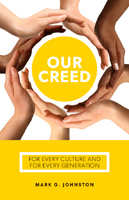
There has been a long-running debate in Christian circles generally and Reformed Christian circles in particular as to whether or not using images of Jesus in children’s Bible story books, or for illustrations in children’s talks, is a breach of the second commandment. It is a genuine debate, and, as with all debates it has two sides.
Those who favour the non-inclusion of images of Jesus do so on the grounds that any visible or tangible representation of God is forbidden, Therefore, since Jesus is the Son of God incarnate, to try and represent him in any such way would violate God’s law. (Their argument is helped unwittingly by many who have no qualms about portraying him because they depict him as Anglo-Saxon, Aryan or American; but never as the Middle-Easterner he was!) The classic exposition of the second commandment set out in the Westminster Larger Catechism (Questions 107-110) seems only to affirm this view.
It would be a mistake, however, not to consider other factors that colour this debate and we ought at least to ask whether or not a reasonable case can be made for the contrary view. I would humbly suggest there is. The paucity of literature discussing this aspect of the debate is surprising, but perhaps that in itself is a reflection of how one-sided it has tended to be, or else how Reformed churches – despite the view of covenant theology many of them espouse – have not always been as thoughtful as they might be when it comes to working with children.
A key point in the discussion should be to look again at the wording and structure of the second command and how it fits into the flow of the Decalogue as a whole. When we do that we should note that the second command is a single command in two parts, not two commands rolled into one. That may seem obvious, but there has been a tendency in some treatments of it to regard it as the latter.
The problem with such an approach is that it turns its opening statement into a tautology – simply reiterating what has been stated in the first commandment. An ‘idol’ or ‘carved image’ is clearly meant to be understood in the sense of a ‘god’ (otherwise it becomes the pretext for a ban on creating any works of art, as at times it was understood in certain sectors of Judaism). The opening clause, therefore, is exegeted by the second: it is wrong to make a carved image with the intention of worshipping it.
Seen in the wider structure of the Commandments, if the first command tells us the God who alone we are to worship, the second tells us how he should be worshipped. (The third command goes on to speak of our attitude in worship – reverence and awe – and the fourth of the context for corporate worship: the day God has set apart for himself.)
The ‘how’ of worship was especially relevant to the Israelite community emerging, as it was, from four centuries surrounded by the idol-worship of Egypt and about to enter the land of Canaan which was also awash with image-centred worship. And, of course, this has also been an enduring issue for God’s people in whatever culture they have found themselves through the centuries. God will not allow the worship his people offer him to be shaped and moulded by the prevailing religious fashions of their day.
So, as we relate this command to the use of images of Jesus for the benefit of children, we should note they are not intended either as objects of worship or aids to worship for the very young. Rather, where they have been used, it is with a view to instructing those who are too young to think in the abstract and who instinctively concretise the concepts communicated to them.
This leads us into another aspect of the debate surrounding this command, namely how it relates to religious art, especially when it is used didactically in contexts where there is low literacy. The Dutch Old Testament scholar, Jochem Douma, makes an interesting observation in relation to this in his commentary on the Ten Commandments:
Is the case any different for images that function merely as “books for the laity”? Undoubtedly it is improper to put all images in the same category and declare them all objectionable. Anyone with a bit of knowledge of French cathedrals, for example, will realise that particularly the extensive sculpturing on church exteriors had clear pedagogical purpose. We find the most important stories from the Old and New Testaments carved in stone. During the Middle Ages, the masses were illiterate, but by means of the church’s portraits and murals, people could still obtain a limited understanding of Bible stories. Perhaps we could compare this to our children, who are able to pick up quite a bit from pictures in their story Bibles. J. Douma The Ten Commandments (P&R; Philipsburg, NJ) 1996 p. 65. (Italics added.)
It is the last sentence in this quotation that stands out. Given, as we have said, that in terms of a child’s intellectual development, he or she can only think in concrete categories until somewhere around the age of ten, there are key elements of the Gospel narratives and how they are presented to children that this affects. Notably the fact that, if Gospel stories are illustrated, but with images of Jesus absent, the message this conveys is one of a Jesus whose ‘body’ was not visible. The key figure in these stories was apparently there, but in a way that could not be seen.
As Derek Thomas pointed out to me many years ago, this runs the very real risk of teaching little children a Docetic view of Christ. Namely, that he only appeared to have a body, but it was not real and was merely some sort of phantasm. Such a view was, of course, firmly rejected by the early church in the 1st Council of Nicaea in AD 325 as a violation of the doctrine of Christ’s true humanity.
Curiously (and purely anecdotally) there seems to be some connection between churches that opt to exclude images of Jesus from their children’s teaching materials and Christians who struggle with the implications of the reality of the humanity of Christ. But that is open to further debate!
My only plea in this little piece is that we should be careful in our work with children not to throw out more than we might think when it comes to how we present Jesus to the very young.

The Alliance of Confessing Evangelicals is member supported and operates only by your faithful support. Thank you.















 © Alliance of Confessing Evangelicals
© Alliance of Confessing Evangelicals


